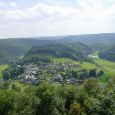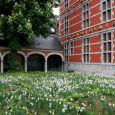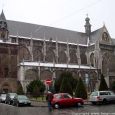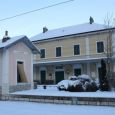Liege
Advertisement
By Air
Aeroport de Liege-Bierset Specialising in freight, the airport is nevertheless home to charter flights and a few regular lines, with routes to/from Agadir, Alicante,Bodrum, Catania, Corfu, Djerba, Heraklion, Hurghada, Ibiza, Izmir, Las Palmas, Malaga, Monastir, Palma de Mallorca, Pristina, Rhodes, Tel Aviv and Tenerife. Reaching the city centre with public transportation is a bit tricky. Check the TEC (local city bus) website for further information.
By Train
Liège-Guillemins is the main station, located on the southwest part of the city. Thalys and ICE high-speed trains serve Brussels, Paris, Aachen, Cologne and Frankfurt. Beware that unlike most train stations in Belgium, Liège-Guillemins is not a walking distance away from the city centre. You can take a bus which cost €1.40 one way, or taxi which cost around 8-10 euros. The cheapest alternative being changing to another train that's heading to the station called "Liège-Palais". The fare of this trip is included in your ticket to Liège-Guillemins. The trip takes around 6 mins.
From Brussels, intercity service runs at least hourly and takes about 60 minutes from Brussels Nord. From Brussels Airport, take the airport shuttle to Leuven and take intercity service from there. From the Netherlands, connect in Maastricht. Trains run at least hourly and take about 30 minutes.
By Bus
Liège is well-connected by bus, notably in the Eurolines network. Eurolines arrivals/departures are on rue des Guillemins, near the train station.
Botrange Nature Park Center
On the Belgian side comprehensive information about the Hohe Venn nature reserve is available from the Botrange Nature Park Center. A permanent exhibition features a relief model of the moor landscape and a slide show of the most beautiful views. A 5km/3mi long educational nature walk leads through the countryside and is marked with seven observation posts giving facts about the flora and fauna. The center also organizes walks, photography courses and introductions to herbal medicine.
Curtius Museum
The Musée Curtius is in the former mansion of the Jean Curtius (1551-1628), once supplier to the Spanish army. Between 1600 and 1610 he had this exemplary red brick house built on the river bank in the style of the Mosan Renaissance. The museum which now occupies the house contains in two departments exhibits from prehistoric, Roman and Frankish-Medieval periods together with furniture and decorative art collections from the Middle Ages to the French Revolution. Only the most notable pieces from its valuable collections are listed: on the ground floor Roman bronzes, a Roman ceramic mask and a unique Roman glass service, Merovingian everyday objects, wonderful early Romanesque ivory carvings including a figure of Christ from Amay and Bishop Notker's Evangelistery (around 1100), the museum's pièce de résistance; on the first floor the finely worked Madonna by Dom Rupert (around 1140), the wooden tympanum with the "Mystery of Apollo" (around 1150), lavishly decorated Renaissance rooms; finally on the second floor a collection of coins from Liège.
St Jacob's Church
South of the cathedral the Rue St-Remy comes to the church of Saint-Jacques (St Jacob's Church), founded in the 11th C. and converted to a splendid example of late Gothic architecture in 1513-1538. The Romanesque portico of 1170 on the west side has been preserved; the magnificent north portal was remodeled by Lambert Lombard in Renaissance style in 1558-1560, but leaving the relief below the arch of the Coronation of the Virgin (1380), a masterpiece of Mosan Gothic sculpture. Worth seeing inside the church are the superb vaulting, the rood- screen (17th C.) and the stained glass (1520-1540).
Musee du Fer Charbon
On the east side of the Ourthe canal the Musée du Fer et du Charbon, a branch of the Musée de la Vie Wallone on the Blvd. Poincaré, specializes in mining and metal working in Wallonia and has a 17th C. melting furnace and 18th C. blacksmiths' hammers.
May - September





